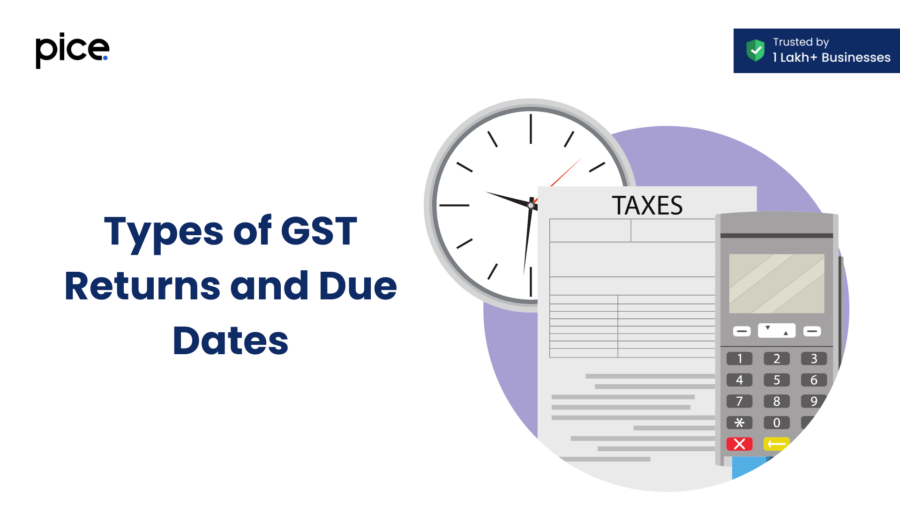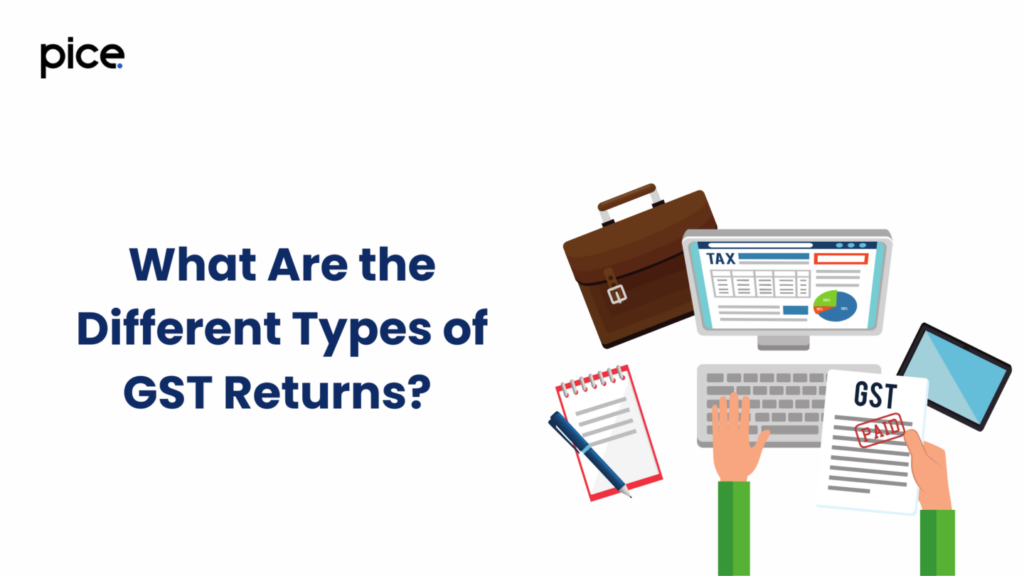GST Return – What Is GST Return? Who Should File, Due Dates & Types of GST Returns
- 29 Aug 24
- 12 mins

GST Return – What Is GST Return? Who Should File, Due Dates & Types of GST Returns
Key Takeaways
- Filing Requirement: All registered businesses must file GST returns regularly to comply with tax laws.
- Variety of Forms: GST returns include 13 different forms, each tailored to specific taxpayer needs and transactions.
- Strict Deadlines: Each return type has specific due dates, with monthly, quarterly, and annual filing schedules.
- Penalty for Delays: Late filing incurs daily fees and interest, making timely submission crucial for cost management.
- Operational Compliance: Accurate and timely GST filings ensure smooth operations and facilitate Input Tax Credit claims.
A GST Return is a mandatory document for registered taxpayers under the Goods and Services Tax (GST) Act, which includes details of sales, purchases, and taxes paid. The various types of GST returns include Form GSTR-1, GSTR-3B and GSTR-9.
While GSTR-1 is filed monthly by businesses with details of outward supplies of goods and services, GSTR-3B is a self-declared summary return. On the other hand, returns like GSTR-9 are filed yearly.
In this blog, we will explore the meaning of GST returns, their due dates and provide a comprehensive guide on who should file them and the different types of GST Returns.
What Is a GST Return?

A GST return is a document businesses file to report their GST liabilities. This includes business transactions like purchases, sales, and tax receipts. Businesses must file these returns within regular tax periods, which is either on a monthly or quarterly basis. GST returns not only ensure compliance with tax regulations but also help in calculating the net tax payments.
Filing of GST returns is mandatory for all registered businesses, even if there are no business activities or transactions. To avoid penalties, ensure you file through official government portals, as accurate GST return filings are crucial. Additionally, timely submission is essential for maintaining a good standing with tax authorities.
Who Should File GST Returns?
All businesses, including sole proprietorships, partnerships, or those with nil returns, must file GST returns.
For regular businesses with an annual aggregate turnover over ₹5 crore and those not using the QRMP scheme, the filing requirement includes two monthly returns and one annual return, resulting in a total of 25 returns each year.
Taxpayers with a turnover of up to ₹5 crore can choose the QRMP scheme, which makes filing easier by reducing the number of returns to 9 per year. This includes 4 GSTR-1 returns, 4 GSTR-3B returns and an annual return.
How Many Returns Are There Under GST?
Under GST, there are 13 types of returns: GSTR-1, GSTR-3B, GSTR-4, GSTR-5, GSTR-5A, GSTR-6, GSTR-7, GSTR-8, GSTR-9, GSTR-10, GSTR-11, CMP-08 and ITC-04. Each return serves a specific purpose and is applicable depending on the type of taxpayer and the nature of registration.
What Are the Different Types of GST Returns?
The different types of GST return forms are as follows:

- GSTR-1 (Outward Supplies Return)
GSTR-1 is a monthly or quarterly return detailing outward supplies of goods or services and is essential for claiming Input Tax Credit. While taxpayers with an annual turnover above ₹5 crore are entitled to file GSTR-1 monthly, those with an annual turnover of up to ₹5 crore follow quarterly filing. Any late filing fee for GSTR-1 will be reflected in the liability ledger of the subsequent GSTR-3B return filed after the delay.
- GSTR-2A (Dynamic View-Only Return)
GSTR-2A is an auto-drafted return for inward supplies of goods or services and is generated from the supplier’s GSTR-1. GSTR-2A helps in reconciling purchases with the supplier’s sales data and is available monthly for normal taxpayers to verify correct tax reporting and compliance on the GST portal. Using this form, you can claim Input Tax Credit.
Since September 2017, GSTR-2 has been suspended due to an amendment to the CGST Rules. It has been replaced by GSTR-3B, which consolidates the functions of both GSTR-2 and GSTR-3 into a single return.
- GSTR-2B (Static View-Only Return):
GSTR-2B is a static-view document for regular taxpayers and is generated monthly. It reflects inward supplies and summarises Input Tax Credit details. The statement used to be available on the GST portal and regular review of GSTR-2B by taxpayers helped in accurate tax reports and optimising ITC. This form was suspended as well, along with Form GSTR-2A in 2017. It also outlined the necessary actions for each reported invoice, indicating whether it should be reversed, deemed ineligible, or subject to reverse charge
- GSTR-3B (Summary Return):
GSTR-3B is a monthly summary return that provides details of both outward and inward supplies, including details of input tax credit claimed, tax liability determined and taxes paid. All normal taxpayers need to file GSTR-3B. However, you should reconcile the data with GSTR-1 before filing GSTR-3B to prevent inaccuracies.
- GSTR-4 (Composition Scheme Return):
This annual GST return is for composition dealers or taxpayers under the composition scheme. It allows those with a goods turnover up to ₹1.5 crores to pay taxes at a fixed rate. Service providers with a turnover up to ₹50 lakh can also opt for a similar scheme.
- GSTR-5 (Non-Resident Foreign Taxpayer Return):
This return form is used by non-resident taxable persons registered under GST to report their business transactions and taxable activities in India. It details their activities while operating within the country.
- GSTR-5A (OIDAR Services Return):
This form is for Online Information and Database Access or Retrieval (OIDAR) service providers. It details the taxable supplies made, credit notes, debit notes and the tax collected. According to the GST Act, Form GSTR-5A must be filed monthly.
- GSTR-6 (Input Service Distributor Return):
A monthly return, GSTR-6 is filed by an Input Service Distributor (ISD) to report the distribution of input tax credit (ITC) among their units. It will also include details of all documents issued for input credit distribution and the method of distribution.
- GSTR-7 (TDS Return):
GSTR-7 is filed by individuals or entities, on a monthly basis, who deduct Tax Deducted at Source (TDS) under GST. This return will include details of the TDS deducted, the TDS liability payable and paid and any TDS refunds claimed.
- GSTR-8 (E-commerce Operator Return):
It is filed by e-commerce operators every month who collect tax at source (TCS). GSTR-8 returns report details of supplies made through e-commerce platforms and TCS collected.
- GSTR-9 (Annual Return)
It is the annual return for regular taxpayers under GST. Form GSTR-9 details all outward and inward supplies for the financial year, categorized under CGST, SGST, and IGST. It also summarizes supplies by HSN code and lists the taxes payable and paid.
- GSTR-9C (Reconciliation Statement)
It is an annual statement for taxpayers with an aggregate turnover exceeding ₹5 crore in a financial year. Previously requiring auditor certification, it now only needs self-certification by an authorized representative of the taxpayer.
- GSTR-10 (Final Return):
GSTR-10 is the final return to be filed upon cancellation of GST registration. This form applies to all registered taxpayers with a few notable exceptions. Input Service Distributors (ISD), Composition Scheme taxpayers, and Non-Resident Taxable Persons (NRTP) are not required to file these returns. Additionally, those required to deduct TDS under Section 51 or collect TCS under Section 52 of the CGST Act are also exempt.
- GSTR-11 (UIN Holder Return)
GSTR-11 is the designated return for entities holding a Unique Identity Number (UIN) to obtain GST refunds on their purchases in India. This UIN, issued to foreign diplomatic missions and embassies exempt from Indian tax liabilities, enables them to reclaim taxes paid on goods and services acquired within the country.
Due Dates for Various Types of GST Returns
The due dates for various types of GST return for taxpayers are as follows:
- GSTR-1: The cut-off date for monthly filers is the 11th of the following month. The due date for quarterly filers is the 13th of the month following the quarter.
- GSTR-3B: Monthly filers must submit Form GSTR-3B by the 20th of the following month. Quarterly filers have due dates that vary by state or UT, typically on the 22nd or 24th of the month after the quarter ends.
- GSTR-4: The due date for filing GSTR-4 is April 30th of the year following the relevant financial year.
- GSTR-5: Non-Resident Taxable Persons need to file GSTR-5 on the 13th of the following month.
- GSTR-5A: You need to file GSTR-5A by the 20th of the following month.
- GSTR-6: The deadline for filing GSTR-6 is the 13th of the month following the current month.
- GSTR-7: It is mandatory to file GSTR-7 by the 10th of the following month.
- GSTR-8: If you are filing GSTR-8, you need to do it by the 10th of the following month.
- GSTR-9: The specified due date for error-free GSTR-9 filings is 31st December of the following financial year. For instance, for FY 2023-24, the time period for filing is December 31, 2024.
- GSTR-10: You must file GSTR-10 within 3 months of the cancellation date.
- GSTR-11: GSTR-11 is due on the 28th of the following month. For instance, the due date is August 28 for July supplies.
These due dates may change, and the government might offer extensions. Always check for updates on the GST portal or the Central Board of Indirect Taxes and Customs website.
Late Filing of GST Returns

The current tax regime mandates timely reporting to ensure compliance. Late filing can result in penalties and interest charges. If you file the returns after the due date, there will be an interest charge on the tax. Furthermore, you cannot submit a new return if you have not filed the previous month's or quarter's return.
Timely filing avoids extra costs and ensures compliance, as interest and penalties can add up, increasing the financial burden. Late returns can also harm a business's credit rating and lead to legal issues.
Therefore, it is important for businesses to maintain proper records and adhere to filing deadlines. To ensure this, individuals must keep an eye on regular updates on return due dates and set automated reminders.
If you do not file the returns timely, it is also likely to affect the statements of Input Tax Credit. This may ultimately affect the overall tax liability.
Moreover, continuous delays or non-filing can lead to scrutiny by tax professionals in India. This could further result in audits or serious legal consequences.
Interest and Late Fees to be Paid
According to GST regulations, the sum of money that you need to pay for late filing of GST returns is known as a late fee. It is either a penalty charge or an interest. However, there are maximum limits on the late fee.
It is determined based on the type of return and the duration of the delay. The longer the delay, the more the late fee.
For late filing of GST return forms, a fee of ₹50 per day applies, plus interest at 18% per annum on the overdue amount from the day after the due date. Businesses should file GST returns on time to avoid penalties and stay compliant.
Conclusion
As we now understand the various types of GST returns and due dates, it is crucial to maintain compliance for smooth business operations. Similar to how GSTR-1 details outward supplies and GSTR-3B provides a monthly summary of liabilities, each type of GST return serves a specific purpose. In addition to ensuring compliance, timely submission of these returns facilitates the processing of Input Tax Credit claims and helps maintain good relations with tax authorities.
💡Facing delays in GST payment? Get started with PICE today and streamline your GST payments. Click here to sign up and take the first step towards hassle-free GST management.
FAQs
What is a GST return, and why is it important?
Who is required to file GST returns?
What are the due dates for filing different types of GST returns?
GSTR-3B: Monthly filers by the 20th, quarterly filers vary by state, typically on the 22nd or 24th.
GSTR-4: By April 30th of the following financial year.
GSTR-9: By December 31st of the following financial year.
Other forms have specific monthly or annual deadlines
 By
By 

















